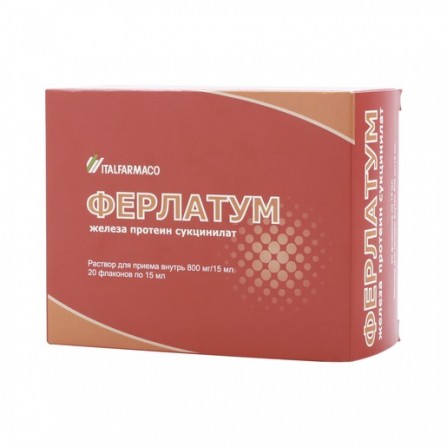Ferlatum solution for oral administration bottle 15ml N20
Condition: New product
1000 Items
Rating:
Be the first to write a review!

More info
Active ingredients
Iron protein succinylate
Release form
Solution
Composition
Active ingredient: Iron protein succinylate (iron proteinsuccinylate) Active ingredient concentration (mg): 800
Pharmacological effect
Antianemic drug. ferlatum contains iron protein succinylate, which is a complex compound where ferric atoms are surrounded by a semi-synthetic protein carrier that prevents damage to the gastric mucosa. The main function of iron is the transfer of oxygen to the tissues. iron is part of hemoglobin, myoglobin, iron-containing cytochrome enzymes, transfers electrons and works as a catalyst for oxidation, hydroxylation and other metabolic processes.
Pharmacokinetics
In the acidic environment of the stomach, precipitation of proteins and the formation around the iron ions of a dense protein shell, eliminating the irritating effect of iron on the mucous membrane of the stomach, occurs. (suction), which explains the impossibility of overdose.
Indications
Treatment of latent and clinically pronounced iron deficiency (iron deficiency anemia); prevention of iron deficiency during pregnancy, during lactation, active growth, with prolonged bleeding, against the background of inadequate and unbalanced nutrition.
Contraindications
Hemochromatosis, iron utilization disorders (lead anemia, sideroachrestic anemia); non-deficient anemia (hemolytic anemia or megaloblastic anemia caused by vitamin B12 deficiency); chronic pancreatitis; cirrhosis of the liver; hypersensitivity to the drug.
Precautionary measures
The drug should be stored out of reach of children at a temperature not exceeding 25 ° C.
Use during pregnancy and lactation
Ferlatum is indicated for the prevention and treatment of iron deficiency states that develop during pregnancy and lactation (breastfeeding).
Dosage and administration
Ferlatum should be taken orally, before or after a meal. An adult drug is prescribed at 15-30 ml / day (in the amountequivalent to 40-80 mg of Fe3 +) in 2 doses. For children, starting from the neonatal period, the drug is prescribed at 1.5 ml / kg body weight / day (in an amount equivalent to 4 mg / kg / day Fe3 +) in 2 doses. be prescribed individually by a doctor. For the prevention of iron deficiency during pregnancy, the drug is prescribed at 15 ml / day; for the treatment of latent or clinically pronounced iron deficiency - 15-30 ml / day in 2 doses. After normalization of serum iron and hemoglobin, therapy is continued for another 8-12 weeks, prescribing Ferlatum in a maintenance dose.
Side effects
On the part of the digestive system: diarrhea, constipation, nausea, epigastric pain (more often with the use of the drug in higher doses) (patient disappears with dose reduction or drug withdrawal) are possible. The patient should be informed that if an adverse reaction occurs, consult a doctor.
Overdose
Symptoms: to date, no signs of intoxication and excessive iron intake have been described; in the first 6-8 hours after the use of iron preparations in excessive doses, epigastric pain, nausea, vomiting (sometimes with blood), diarrhea, in some cases accompanied by drowsiness, pale skin, may occur. Development of a shock condition up to a coma is possible. Treatment: gastric lavage; if necessary, conduct symptomatic therapy.
Interaction with other drugs
With simultaneous use of Ferlatum with histamine H2-receptor blockers, there is no pharmacological interaction. Chloramphenicol causes a delayed response to iron therapy. Pharmacokinetic interaction If you take iron at the same time, disrupt the absorption of tetracyclines from the gastrointestinal tract (this combination should be avoided). ascorbic acid in a dose of more than 200 mg. The absorption of iron decreases while om the appointment of antacids.
special instructions
It should be borne in mind that the total duration of taking Ferlatum should be no more than 6 months, except for cases associated with chronic blood loss (menorrhagia, hemorrhoids), and pregnancy.




